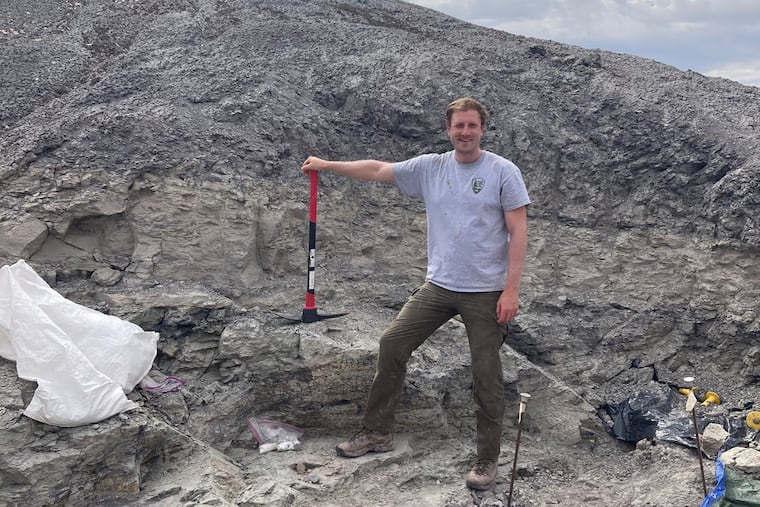Fossil guy finds ‘funky worm’ with a Philly hook
Ben Kligman named his 220 million-year-old find after a funky tune and a mentor at the Academy of Natural Sciences.

Ben Kligman thinks he found his first fossils on a family hike at age 5 or 6 — perhaps some prehistoric shark teeth in South Jersey, or the remains of crablike creatures called trilobites near Harrisburg. Great stuff to fire the imagination of a kid growing up on the Main Line, but fairly easy to find if you know where to look.
Now 29 and a professional paleontologist, Kligman is winning scientific acclaim this month for digging up something no one had seen before: an odd, wormlike creature that lived 220 million years ago, give or take a few years.
He calls it “funky worm” after a 1972 song by that name, which he and colleagues often listened to as they dug through the rock in Arizona’s Petrified Forest National Park. In Latinized form, the creature’s formal scientific name is Funcusvermis gilmorei — the second part in honor of Kligman’s mentor, collections manager Ned Gilmore at the Academy of Natural Sciences of Drexel University.
» READ MORE: Famous fish fossil takes final bow in Philadelphia
Technically, the burrowing animal is not a worm at all, but an amphibious critter called a caecilian (unlike worms, it has a spine). Still, the hook was catchy enough to get the discovery on the Feb. 2 cover of Nature, the prestigious British science journal.
The find is making waves because until now, the oldest known caecilian fossils were from 183 million years ago. But scientists have determined that these animals must have been around far longer, at least as early as 275 million years ago. That date came from an analysis of the DNA of modern caecilians and their cousins, frogs and salamanders, allowing researchers to estimate when they must have branched apart from each other on the tree of life.
So why had no one found the remains of older caecilians? Turned out scientists had not been looking in the right place, said Kligman, who grew up in Tredyffrin Township and is now earning a Ph.D. at Virginia Tech.
He and his colleagues were not looking for caecilians, but any creatures from the Triassic Period, which began 252 million years ago — after a mass extinction event that was far worse than what killed the dinosaurs, wiping out most forms of life on Earth.
“It kind of wipes the slate clean,” Kligman said.
It’s not clear what environmental catastrophe caused the big die-off, but among the types of animals that could survive it, probably, were small ones.
So at the national park in Arizona, where Kligman works in the summer, he and colleagues dug through thousands of pounds of rock to reach a geologic layer corresponding to the mid-Triassic. They then took samples of the sediment back to their lab, and picked through it with tweezers, searching for the remains of small animals.
Lo and behold, one day in the summer of 2019, a team member found the funky worm. Or at least, parts of it, including a distinctive double row of teeth, and slender vertebrae that would have allowed it to burrow underground.
Several years of work ensued, during which Kligman and his colleagues found dozens more examples of the new species. Kligman led the painstaking work of describing the various fossilized body parts and analyzing how the animal fit into the tree of life.
“It kind of feels like you’re in a spaceship landing on an alien planet, and you’re the first person to see all these things that no one’s ever seen before,” he said.
» READ MORE: What separates us from the worms
Then he approached Gilmore, of the Academy of Natural Sciences, to ask if he minded lending his last name to the new find.
Gilmore was touched.
“It’s fun,” he said. “I’ve got to frame it and put it up on the office wall.”
Kligman also got the OK from members of the Ohio Players, the Dayton-based band that performed “Funky Worm.” The tune was on their 1972 album and was released as a single in 1973.
Speaking to the Dayton Daily News, drummer James “Diamond” Williams joked that the honor was appropriate, given the group’s longevity.
“We compare in age to the fossil, so he’s part of our brotherhood,” he said. “Seriously, though, it’s amazing any time you are part of something as important as this will be. This fossil will last longer than ‘Funky Worm’ and already has, by comparison.”